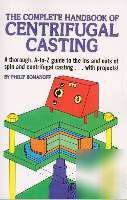Spin casting and centrifugal casting. How to make white metal, pot metal parts.
Castcraft Moldmaking and Casting How-To Books, Videos, Projects, and Plans
by Philip Romanoff. 256 pages. 5" x 8". Black and white photos.
How to make Products with Centrifugal or "Spin Casting" equipment
* Spin Casting is used to make large quantities of small metal or plastic products with relatively inexpensive machinery. Instead of the hundreds of thousands of dollars that is required for large scale injection molding machinery, spin casting equipment is in the $10-20,000 range.
* The author shows how and why spin casting works, and shows the best "white metal" alloys to use for a given application. He shows the necessary equipment and supplies, and shows which silicone rubber materials are best for making the spin casting molds, and how to make the molds.
Example Projects are shown in detail to show how centrifugal casting problems can be solved
* Example projects include a cigarette lighter, a battery lug and lug nut, sculptures and figurines, window hardware, and a steering wheel.
Centrifugal Casting is also known as spin casting. A basic spin casting machine works like this: A two-part high-temperature silicone rubber mold is clamped between pressure plates on the spin casting machine. The spin casting machine rotates the mold at high speed, similar to a washing machine on the spin cycle. While the mold rotates, molten metal (or fast-setting plastic resin) is poured into a central funnel that feeds into the mold. Centrifugal force carries the metal or plastic into the far reaches of the mold. Because the centrifugal force acts to increase the pressure on the casting material, castings with relatively thin parts can be made. A mold for a spin casting machine is often designed to make a dozen or so identical parts at one time, with the mold cavity for each part equally spaced around the disk of the rubber mold. The typical metal used in this type of spin casting machine is known as "white metal" or "pot metal" and is usually an alloy of zinc.
Other types of small spin casting machines are used by jewelry makers, usually to cast small amounts of precious metals, and not using rubber molds.
What can you make with a Centrifugal Casting Machine?
You can make all the same sorts of small metal (or plastic) objects as listed at right.
Can you make your own spin casting machine?
A spin casting machine could be home made, because it is a relatively simple device, and most of the early machines could be considered "shop built". But newer machines have much better production features and safety features, and if you are serious about producing large quantities of small metal parts, a ready-made spin casting machine would be the best investment. Plus, most spin casting equipment is sold with complete training and the equipment for all phases of spin casting production, including the necessary moldmaking and metal melting equipment.
"The Complete Handbook of Centrifugal Casting" is by an expert in the subject. The book does not have plans to build a machine, but shows how and why a centrifugal casting machine works, what you can do with it, how molds are produced, and so on. Plus, the author is available as a consultant if you want to set up a spin casting operation.
You have seen many commercial products made by centrifugal casting, including:
Belt buckles, battery lug nuts, lock parts, "pot metal" gears and machine parts, bushings, medallions, figurines, souvenirs, memorial coins and plaques, toy and model parts, concrete expansion fasteners, hardware such as drawer pulls and knobs, handles, and decorative wall switch plates.
